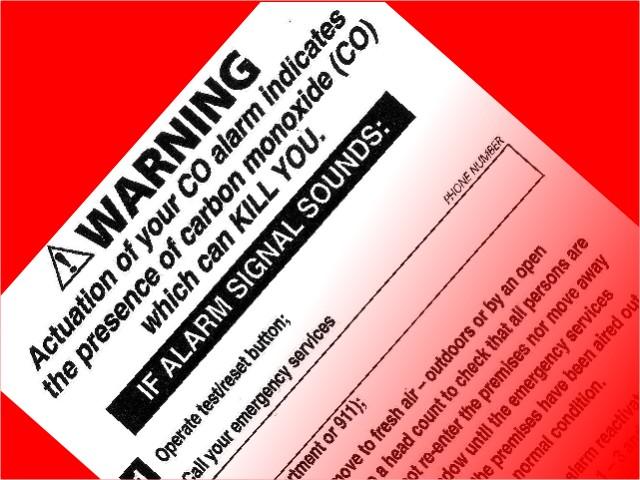
 CO alarm maintenance – this another extremely important house maintenance task doesn’t require any special skills from you. However, just like the smoke alarm maintenance it is something that should become a routine for you. A few minutes dedicated to CO alarm maintenance and testing might be a difference between life and death.
CO alarm maintenance – this another extremely important house maintenance task doesn’t require any special skills from you. However, just like the smoke alarm maintenance it is something that should become a routine for you. A few minutes dedicated to CO alarm maintenance and testing might be a difference between life and death.
Between 1999 and 2004, Carbon Monoxide poisoning contributed to 16,447 deaths in the United States… just a few minutes of their time could lower those numbers.
If your house has been equipped with a security / burglar alarm – contact your service provider and let them know about testing and CO alarm maintenance procedures. CO alarm / detector might be a part of the system. While testing the alarm, you may want to cover the siren opening with your fingers – properly functioning CO alarm will be very loud.
An important CO alarm maintenance item is testing it once a week by pressing the Test/Reset button – simple, isn’t it…
Depending on the design and manufacturer, the response of the CO alarm may be different, usually you should hear one short beep followed by a few seconds of silence, and a few additional beeps. This might be in addition to a blinking light, strobe like effect, or voice warning announcement.
 1. Start CO alarm maintenance from examining its location, it’s as important as regular CO alarm maintenance and testing. If the alarm has been installed improperly, in a wrong spot, it might not respond to an elevated carbon monoxide level as soon as it supposed to, or not respond at all.
1. Start CO alarm maintenance from examining its location, it’s as important as regular CO alarm maintenance and testing. If the alarm has been installed improperly, in a wrong spot, it might not respond to an elevated carbon monoxide level as soon as it supposed to, or not respond at all.
Check the following link – where to install CO detector, or at least watch the short video below that shows those locations.

2. Check the manufacturer date on you CO alarm (there’ should be a label attached to the back wall of the device) and contact its manufacturer (the easiest way would be to check their website) to determine the life span of this particular model.
CO alarm has a limited life-span
The average life-span is around five years, but some might have as little as 2 year warranty, while others 6-10 years. Replace with a new device immediately if you confirm that its warranty has already expired.
3. Another step in CO alarm maintenance procedures is vacuuming – do it once a month / remove accumulated dust from its cover. The soft brush attachment from your vacuum cleaner is the best for this purpose. If your carbon monoxide alarm is a plug-in or hard wired type – unplug / disconnect the alarm from the electrical power supply before vacuuming.
 4. Always instruct children never to touch, unplug or otherwise interfere with the CO alarm. Educate children of the dangers of Carbon Monoxide poisoning.
4. Always instruct children never to touch, unplug or otherwise interfere with the CO alarm. Educate children of the dangers of Carbon Monoxide poisoning.
5. Never use any detergents or solvents for CO alarm maintenance purposes. Chemicals can temporarily contaminate the sensor or cause permanent damage to this life saving device.
6. Never use air fresheners, spray paint, hair spray, or any other aerosols in the CO alarm area.
7. Do not paint the CO alarm enclosure. Paint will seal the vents / screens protecting the sensor and interfere with its proper operation.
8. Believe it or not, but mounting the CO alarm directly above or near a diaper pail can cause faulty readings on the digital display (high amounts of methane gas).
9. Before you begin:
- staining or stripping wood floors
- furniture painting
- wall-papering using aerosols or adhesives
10. Remove the CO alarm from the location you’ll be performing this work in order to prevent possible damage or contamination of its sensor. You may also cover the unit with a plastic bag for the duration of the project – remember to remove the plastic and / or reinstall the CO alarm as soon as the work has been completed and area well ventilated.
Do Not Use Rechargeable Batteries in Carbon Monoxide alarms. Only alkaline type batteries should be used. Replace the batteries as soon as the unit starts chirping an audible low battery alarm, and blinking warning lights – don’t just remove the old batteries – REPLACE THEM as soon as possible!
High levels of the substances listed below can affect the CO alarm sensor. Their presence could result in temporary readings on the digital display that are actually not carbon monoxide readings:
Methane, propane, iso-butane, ethylene, ethanol, alcohol, iso-propanol, benzene, toluene, ethyl acetate, hydrogen, hydrogen sulfide, sulfur dioxides, most aerosol sprays, alcohol based products, paints, thinners, solvents, adhesives, hair sprays, after shaves, perfumes, auto exhaust (cold start) and some cleaning agents.
Two of the major CO alarm manufacturers and links to pages where you can locate manuals (please report to me if any of the links are broken);
Never ignore an alarming CO alarm! It is warning you of a potentially deadly hazard.



Comments are closed.